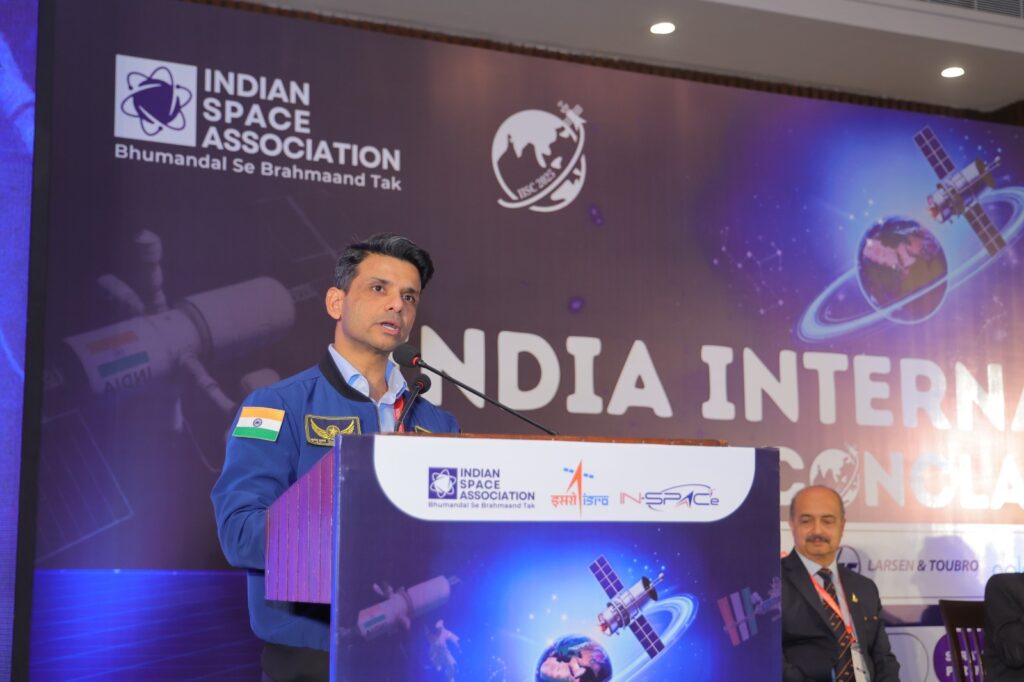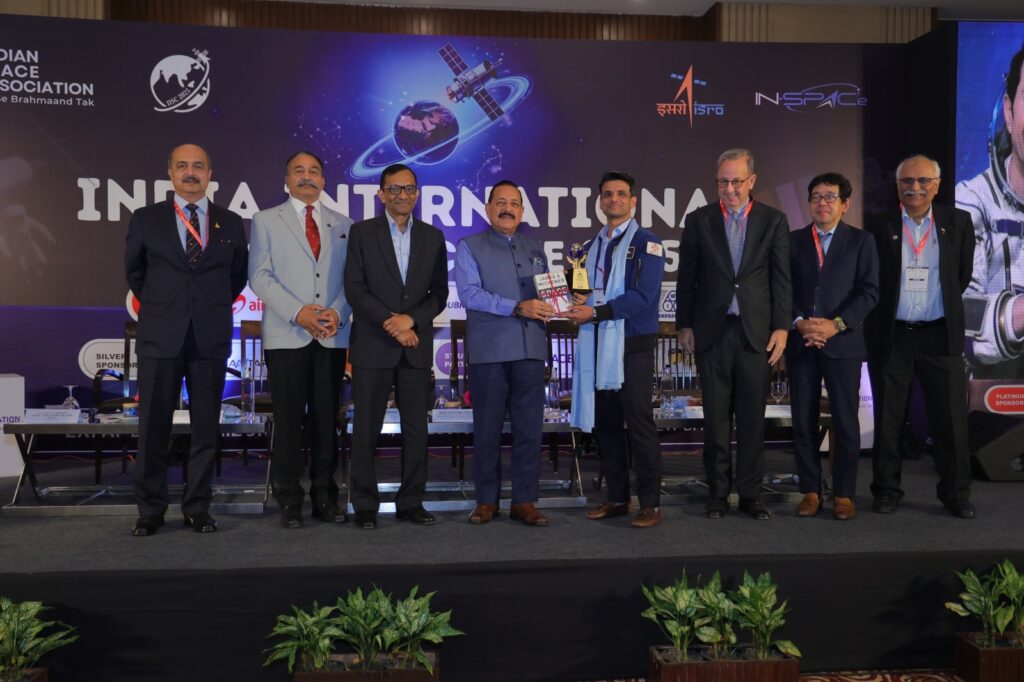Kamal Shah
The dawn of a new space era was powerfully heralded at the fourth edition of the India International Space Conclave (IISC) 2025, inaugurated today in New Delhi by the Indian Space Association (ISpA). This edition of the conclave radiated energy, optimism, and ambition — all centered around one key message from industry leaders and international delegates alike: India must now take a bigger, more collaborative role in shaping the global space economy.
With partnerships spanning continents and visions extending beyond the stratosphere, the event underscored India’s growing influence in the evolving space landscape. Co-hosted by ISRO and IN-SPACe alongside ISpA — the country’s premier association of space and satellite companies — IISC 2025 serves as a dynamic platform for industry, government, and academia to converge and envision the future of space exploration and commercialization.
A Historic Moment for the Indian Space Ecosystem
The conclave opened with great enthusiasm, attended by dignitaries who personified international cooperation and India’s scientific spirit. Dr. Jitendra Singh, Hon’ble Minister of State (IC) for Science & Technology and the Department of Space, inaugurated the session as Chief Guest, joined by luminaries like Dr. Pawan Goenka, Chairman of IN-SPACe; Mr. Takashi Ariyoshi, Minister & Deputy Chief of Mission, Embassy of Japan to India; H.E. Antonio Bartoli, Ambassador of Italy to India; Air Chief Marshal V.R. Chaudhari (Retd.), and Gp Capt Shubhanshu Shukla, ISRO astronaut. Their collective presence symbolized not just policymaking and technological dialogue, but also a united commitment to an inclusive, sustainable, and globally integrated future space.
The Indian Space Revolution: From Reforms to Results
Dr. Jitendra Singh’s opening remarks set an electrifying tone for the day. His reflections on India’s space reforms underscored how far the nation has come in just half a decade. “Space reforms in the last five years have been a turning point,” he said, emphasizing that until recently, space was not even recognized as a segment of the national economy. Today, India’s space economy stands strong at approximately $8 billion, and the projection for the next decade is both breathtaking and believable: a surge to $44–45 billion.
Dr. Singh highlighted a deeply human aspect to this progress — that 70% of India’s space applications have been designed for ease of living and citizens’ welfare. This people-centric vision distinguishes India’s space trajectory from many other spacefaring nations. As technologies such as satellite navigation, remote sensing, and communication networks increasingly shape daily life, India’s space programs are evolving not merely for exploration but also to empower its people.

Embracing Collaboration: The Global Community Joins Hands
International voices lent further weight to the spirit of collaboration. H.E. Antonio Bartoli, the Ambassador of Italy to India, praised India’s remarkable technological strides, calling the nation an “increasingly key player in the global space arena.” Citing Italy’s reputation as one of the few countries spanning the entire value chain, Bartoli called for deepening Indo-Italian cooperation, noting the natural complementarities between the two nations’ industrial ecosystems.
Similarly, Japan’s Minister & Deputy Chief of Mission, Takashi Ariyoshi, expressed admiration for the expanding partnership between the two democratic nations. He invoked the shared values and trust that underpin Indo-Japanese engagement — from security and innovation to joint missions in lunar exploration and climate monitoring. “Our progress in lunar missions, climate initiatives, and space science,” he noted, “reflects the strength of our collaboration and our shared commitment to the future.”
Together, these messages conveyed a powerful consensus: the era of isolated national programs has given way to a globally interconnected, innovation-driven ecosystem — one in which India is rightly positioned at the center.
Inspiration from the Stars: Voices of Experience & Hope
Perhaps one of the most moving moments of the conclave came from Gp Capt Shubhanshu Shukla, Astronaut, ISRO, who shared his personal reflections as a spacefarer. Speaking with heartfelt sincerity, he narrated how young minds back home connected emotionally with his mission, saying, “We didn’t know there was an ISS in space before you went; we cared because you were there.” His message was clear and universal — representation and inspiration matter.

“When you see someone like yourself doing things you find impossible, it gives you courage to dream,” he reminded the audience. His powerful statement, “Sky was never the limit. Not for me, not for you, and not for Bharat,” resonated as more than an inspiring line; it was a rallying cry for a nation and a generation aiming beyond perceived constraints.
Building the Future: Public-Private Synergy & Innovation
As the conclave’s discussions unfolded, one theme emerged as a common thread — collaboration. Whether between nations, private enterprises, or institutions, cooperation is essential for sustained innovation and inclusive growth. The presence of IN-SPACe and leading private players signals that India’s space ecosystem is shifting decisively toward an open-participation, entrepreneurial model.
With start-ups entering the fold, young innovators designing India’s next-generation satellites, and new commercial launch services taking root, the Indian space economy is no longer solely focused on government-led missions. It is transforming into a vibrant marketplace of ideas, technologies, and partnerships that span industries and borders alike.
India’s space journey has always been one of courage, resilience, and boundless imagination. From humble beginnings with rocket parts transported on bicycles to breathtaking lunar and interplanetary missions, the nation has consistently demonstrated what vision and perseverance can achieve. Today, as the country stands on the threshold of a new era of space exploration, a vibrant partnership among government agencies, private enterprises, academia, and international collaborators is powering an unprecedented transformation. The recent conclave highlighted how this synergy is shaping India’s space future, marked by bold innovation, fresh investment, and an expanding global footprint.
At the heart of this momentum lies a unified vision—one that harmonizes the roles of the Indian Space Research Organisation (ISRO), the Indian National Space Promotion and Authorization Centre (IN-SPACe), and the Indian Space Association (ISpA). Together, they are forging a robust ecosystem that blends the strengths of policy, science, and industry to create a self-sustaining space economy.
Dr. Pawan Goenka, Chairman of IN-SPACe, captured this exciting evolution perfectly when he noted how far India has come in just a year—how deeply collaboration has flourished across borders and how enthusiastically private companies are stepping in to shape the infrastructure of the future. His remarks echo a powerful truth: the success of India’s space sector will depend not just on building systems but on generating a vibrant demand for space-based services and solutions. His advice—think big, take no shortcuts, embrace perseverance, and pursue collaboration—resonates as a rallying call for both established players and young startups eager to redefine the frontier.

Equally inspiring are the reflections of AT Ramchandani, Sr. VP & Head of Precision Engineering & Systems at L&T and Chairman of ISpA. He reminded everyone that India’s space journey has been sculpted by pioneers who turned limitations into possibilities. With ISRO, IN-SPACe, and private industry now aligned, a new canvas is emerging—one brimming with innovation, competitiveness, and readiness for the future. His commitment to uniting the sector, government, and academia underscores a pragmatic yet optimistic approach: collaborative innovation is not just desirable; it is essential. The Indian space ecosystem is maturing swiftly and seeks not only to compete globally but also to lead.
Adding another dimension to this growing optimism, Lt. Gen. A.K. Bhatt (Retd.), Director General of ISpA observed that India’s space sector is attracting tremendous international interest. Trade agencies, innovators, and governments worldwide recognize India’s potential as a dynamic hub for space technology, manufacturing, and services. His emphasis on strengthening collaborations, especially with strategic partners such as Japan, points to a future in which India’s space industry contributes decisively to global security, innovation, and exploration. Such alliances are not merely transactional—they are transformational, defining a resilient and thriving global space industry with India in a leading role.
One of the highlights of the event was the announcement of the partnership between Viasat India and BSNL. This collaboration promises to revolutionize the low-altitude economy by enabling secure beyond-visual-line-of-sight (BVLOS) operations for uncrewed aircraft systems. With Viasat’s advanced Velaris satellite connectivity technology, this partnership will support a range of critical applications—from aerial infrastructure monitoring to emergency medical transport. Gautam Sharma, Managing Director of Viasat India, expressed pride in launching this initiative, emphasizing that it would strengthen India’s capabilities in unmanned aerial operations while fostering innovation with startups and national partners. The initiative marks a significant step toward integrating satellite communication with next-generation aerial technologies, ensuring that India’s skies are as dynamic and connected as its space endeavours.
Novaspace’s announcement of opening an office in Bengaluru further reflects the growing international confidence in India’s space ecosystem. By establishing a local presence, Novaspace aims to deepen its collaborations with government agencies, industries, and startups while expanding its market-intelligence and consulting network. This move perfectly aligns with India’s ambition to become not just a participant but a global leader in the commercial space economy.
Complementing these developments, the conclave also saw the unveiling of pivotal publications, including “Valuation and Fundraising in Aerospace Startups: TRL vs. MRL — India’s Road to Space Industrialization”, the India DefSpace Symposium 2025 Technical Report, and the ISpA–Satsure Joint Paper on Agristack Solutions. These intellectual contributions underscore that India’s space ecosystem is evolving not only through technological breakthroughs but also through a growing body of knowledge, policy blueprints, and academic collaboration. Over the two-day conclave, more than 100 delegates and 600+ attendees—from government officials and global leaders to innovators and policymakers—joined forces to transform dialogue into action.
The Indian Space Association (ISpA) has emerged as the nucleus of this movement. Established under the visionary guidance of the Hon’ble Prime Minister Shri Narendra Modi, ISpA serves as the premier industry body for space and satellite organizations in India. It serves as a vital bridge between private industry and the government, ensuring an inclusive approach to space policy, research, manufacturing, and investment. ISpA’s efforts to promote policy advocacy and stakeholder engagement reinforce the government’s commitment to empowering the private sector while maintaining the highest standards of national and global collaboration.
Ultimately, what sets this moment apart in India’s space narrative is the depth and diversity of participation. Startups with bold ideas are working alongside century-old corporations; international giants are partnering with public sector institutions; and policymakers are crafting frameworks to balance innovation with sustainability. The convergence of these forces promises to make India a global center for satellite production, space-launch services, data analytics, and downstream applications that enrich every sector—from agriculture and logistics to defence and telecommunications.
In essence, India’s space odyssey has entered its most thrilling chapter yet—a chapter of vision, vigour, and vast opportunity. What began as a scientific aspiration has evolved into a multi-sectoral enterprise that unites technology, business, and geopolitics under one grand mission: to make space accessible, sustainable, and transformative. The encouragement from leaders like Dr. Goenka, Mr. Ramchandani, and Lt. Gen. Bhatt is fuelling a generation of dreamers and doers who refuse to see the sky as a limit but as an invitation.
With collective perseverance, shared innovation, and unwavering collaboration, India is not merely reaching for the stars—it is building the bridges that will take humanity there. The countdown to a new era of India’s space dominance has begun, and the launch trajectory points directly toward a future filled with boundless possibilities.
The Road Ahead: India’s Expanding Cosmic Role
If the spirit of IISC 2025 could be summed up in a single vision, it would be this: India is ready to lead not just by launching rockets, but by building bridges. Bridges between nations, between innovation and accessibility, and between aspiration and achievement. The conclave underscored that space is not a distant dream; it is the next excellent global economy — and India’s active leadership is essential to shaping it.
With a clear commitment to inclusivity, collaboration, and sustainability, India’s space story now extends far beyond its launch pads. It is about transforming imagination into industry, exploration into empowerment, and ambition into reality.


